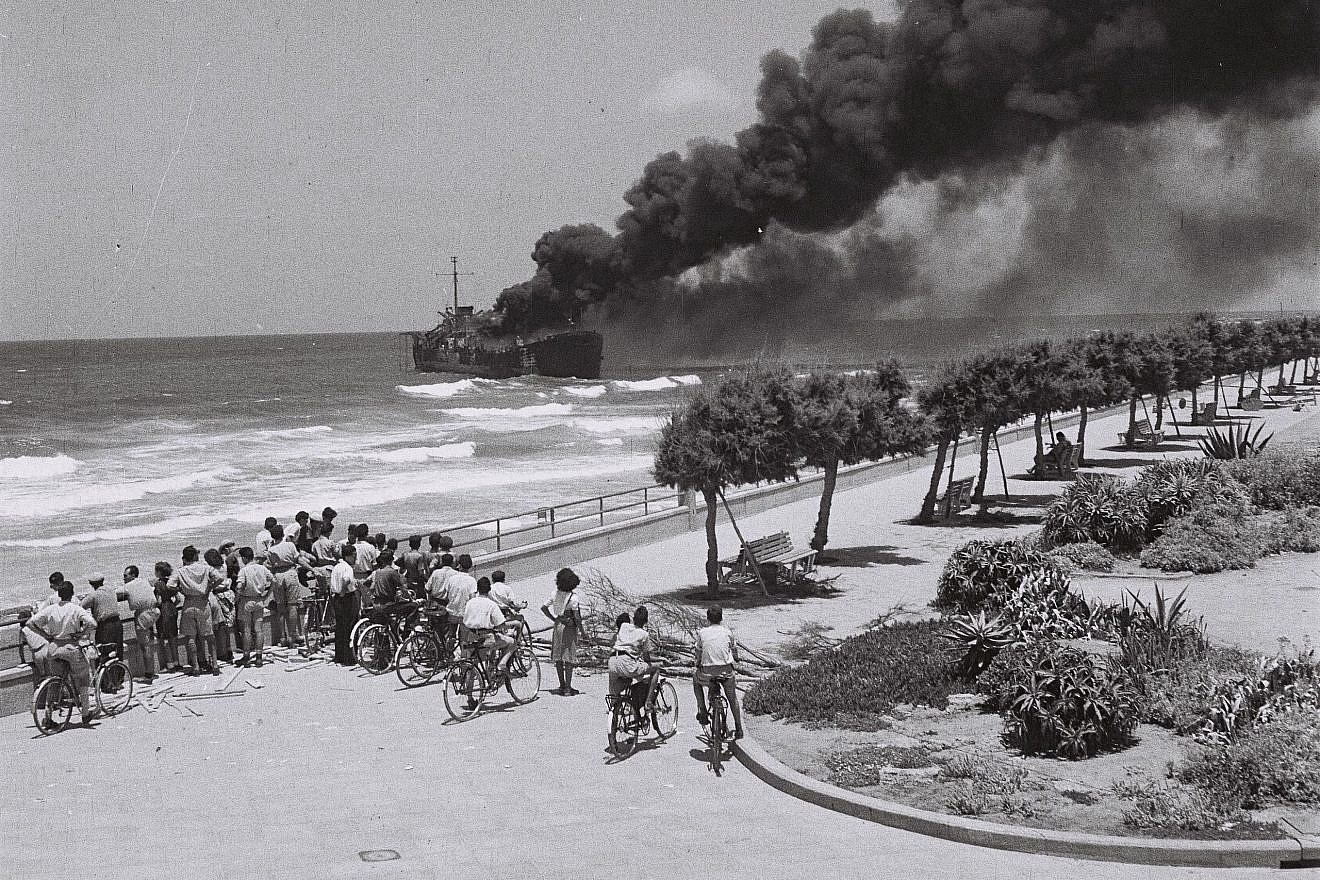by Natan Galula
The 1948 destruction of the Irgun ship is politically contentious to this day.

Israel’s Ministry of Heritage has invested a million shekels (~$296,000) to locate the remains of the Altalena, the Irgun cargo ship that the newly created IDF shelled in a violent confrontation off the Tel Aviv beach in June 1948, public broadcaster Kan’s Reshet Bet radio station reported on Monday.
About a year after the battle, the Altalena, which had run aground at the foot of David Frischmann Street, was refloated, towed 15 miles out to sea, and sunk.
The ministry hired the services of the Israel Oceanographic and Limnological Research Institute (IOLR), through the Survey of Israel (a government department responsible for mapping Israel), to locate the remains of the ship, the report added.
Israel’s national research vessel, the Bat Galim, will be deployed with advanced technological means in an effort to detect the ship, Kan reported.
The search is still in its preliminary stage, intended to identify the area where the remains are located.
Some Hebrew media reports said the government was considering refloating the ship once it is found, but that such a project would require significant resources.
The goal of the search is to convey a message against internal division, while also raising awareness of the important historical role of the Revisionist Zionists—the ideological forefathers of the Likud Party.
The Altalena Affair was one of the most dramatic political events in the early history of the modern-day Jewish state.
The ship, carrying weapons and fighters, was operated by the Irgun, a Zionist paramilitary group during British Mandatory Palestine, an ideological offshoot of Revisionist Zionism. Led at the time by Menachem Begin, who later became the leader of the Likud Party and then prime minister in 1977-83, the Irgun struck an agreement with then-Prime Minister David Ben-Gurion’s provisional government to integrate its units into the Israel Defense Forces—the successor to the Haganah—on June 1, 1948.
The preparations for purchasing and sailing the Altalena vessel, however, were made before cementing the agreement and took longer than expected.
Unbeknown to Begin, the ship raised anchor on June 11 from Port-de-Bouc, France. It set sail on the same day that the first truce of the War of Independence began—a truce that banned new weapons and fighters.
Another point of contention was Begin’s request to transfer 20% of the ship’s weapons to the Irgun’s Jerusalem Battalion, which was not incorporated into the IDF due to the city’s international status.
On the Israeli coast
The vessel arrived at Israeli shores on June 20, and began to unload its cargo in Kfar Vitkin, a small town near Netanya. The provisional government ordered the Irgun to hand over all weapons to the IDF and assigned a military brigade to use force if necessary.
The sides failed to reach an agreement, shots were fired and two IDF soldiers and six Irgun fighters died. It is disputed which side fired first.
Begin ordered the ship to sail to Tel Aviv, where the Irgun had more supporters. The Altalena arrived at midnight as locals, journalists and U.N. observers watched the scene unfold.
Violent clashes resumed the following day. The IDF employed heavy guns and started shelling the vessel. Begin, who went on board the ship, ordered his men to stand down in an attempt to avert civil war. Despite raising a white flag, the firing continued, with confrontations erupting on the beach and throughout Tel Aviv between IDF and Irgun forces. A ceasefire was struck on June 22, followed by mass arrests of Irgun members. In total, 16 Irgun fighters and three IDF soldiers were killed.
As noted above, the Altalena was later sunk some 15 miles offshore.
In a Cabinet meeting this week, Minister of Heritage Amichai Eliyahu said that the government was exerting efforts to locate the ship, and that in the meantime, the “holy cannon” used to shell Altalena should be placed at the Menachem Begin Heritage Center in Jerusalem, Hebrew-language newspaper Makor Rishon reported.
The “holy cannon” was a nickname given to the heavy gun that fired on the Altalena, to express the supposed righteousness of the decision to subdue the Irgun with violence—a term that many Israelis deem offensive to this day.
Justice Minister Yariv Levin agreed with Eliyahu, saying that the Altalena should “become a monument and a symbol of the bravery of the Revisionists,” according to Makor Rishon.
The heritage minister, speaking to Israel’s Channel 14, said, “For years, the legacy of the Revisionists was suppressed; there was no desire to acknowledge them. What interests us is not the steel of the Altalena but the story, the wound. ‘The holy cannon prevented a civil war,’ in Ben-Gurion’s words, by killing 16 Irgun fighters.”
Herzl Makov, CEO of the Begin Heritage Center, said in 2012 that the location of the vessel is known, but reaching it is technologically challenging, Makor Rishon reported.
Previous attempts have used means suitable for shallow waters, but the Altalena is probably farther down.
“The equipment we had at the time couldn’t reach such depths,” Makov was quoted as saying. “What we do have from that search is a radar image that showed the remains of a ship resembling the Altalena. But we don’t have a clear picture, and the cost of equipment capable of reaching those depths is much higher.”
Makov noted that the “holy cannon” currently displayed at the Glilot military base in Ramat Hasharon is not the actual cannon that shelled the Altalena in 1948, but rather one of the same type.
Natan Galula
Source: https://www.jns.org/israel-looking-for-wreck-of-the-altalena-in-bid-for-national-unity/
No comments:
Post a Comment